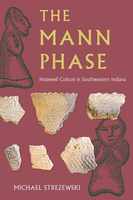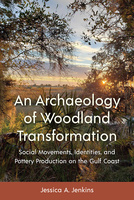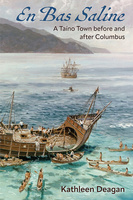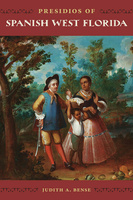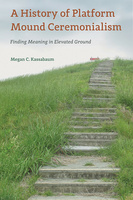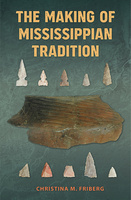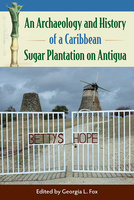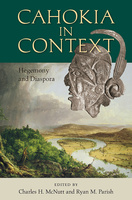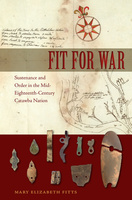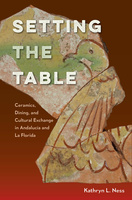The Mann Phase
Hopewell Culture in Southwestern Indiana
This book provides a comprehensive overview of the Mann site in southwestern Indiana, which dates to 200‒600 CE and is one of the most consequential but enigmatic archaeological sites of the Middle Woodland period.
An Archaeology of Woodland Transformation
Social Movements, Identities, and Pottery Production on the Gulf Coast
In this book, Jessica Jenkins provides a detailed look at the transition from the Middle to Late Woodland periods in the Lower Suwannee region of Florida’s Gulf Coast, drawing on ceramic analysis techniques to explore a period of transformative change.
Mississippian Women
This volume highlights the vital role women played within the diverse societies of the Mississippian world, which spanned the present-day United States South to the Midwest before the seventeenth century.
Taíno Indian Myth and Practice
The Arrival of the Stranger King
Unearthing the Missions of Spanish Florida
This volume presents new data and interpretations from research at Florida’s Spanish missions, drawing on the past thirty years of work at sites from St. Augustine to the panhandle.
Methods, Mounds, and Missions
New Contributions to Florida Archaeology
New Methods and Theories for Analyzing Mississippian Imagery
Exploring various methodological and theoretical approaches to pre-Columbian visual culture, the essays in this volume reconstruct dynamic accounts of Native American history across the U.S. Southeast.
Falls of the Ohio River
Archaeology of Native American Settlement
Falls of the Ohio River presents current archaeological research on an important landscape feature of what is now Louisville, Kentucky, demonstrating how humans and the environment mutually affected each other in the area for the past 12,000 years.
A History of Platform Mound Ceremonialism
Finding Meaning in Elevated Ground
This book presents a temporally and geographically broad yet detailed history of an important form of Native American architecture, the platform mound, revealing unexpected continuities in moundbuilding over many thousands of years.
The Historical Turn in Southeastern Archaeology
This volume uses case studies to capture the recent emphasis on history in archaeological reconstructions of America’s deep past, representing a profound shift in thinking about precolonial and colonial history and helping to erase the false divide between ancient and contemporary America.
The Making of Mississippian Tradition
Christina Friberg investigates the influence of Cahokia, the largest city of North America’s Mississippian culture between AD 1050 and 1350, on smaller communities throughout the midcontinent. This book offers a new, more nuanced interpretation of how and why Mississippian lifeways developed.
Archaeology in Dominica
Everyday Ecologies and Economies at Morne Patate
This volume examines the everyday lives of enslaved and free workers at Morne Patate, an eighteenth- and nineteenth-century Caribbean plantation, helping document the under-represented history of slavery and colonialism on the edge of the British Empire.
Modeling Entradas
Sixteenth-Century Assemblages in North America
This volume brings together leading archaeologists working across the American South to offer a comprehensive, comparative analysis of Spanish entrada assemblages, providing insights into the sixteenth-century indigenous communities of North America and the colonizing efforts of Spain.
Contact, Colonialism, and Native Communities in the Southeastern United States
An Archaeology and History of a Caribbean Sugar Plantation on Antigua
This volume uses archaeological and historical evidence to reconstruct daily life at Betty’s Hope plantation on the island of Antigua, one of the largest sugar plantations in the Caribbean. It demonstrates the rich information that multidisciplinary studies can provide about the effects of sugarcane agriculture on the region and its people.
Bears
Archaeological and Ethnohistorical Perspectives in Native Eastern North America
Although scholars have long recognized the mythic status of bears in indigenous North American societies of the past, this is the first volume to synthesize the vast amount of archaeological and historical research on the topic. Bears charts the special relationship between the American black bear and humans in eastern Native American cultures across thousands of years.
Bioarchaeology of the Florida Gulf Coast
Adaptation, Conflict, and Change
Cahokia in Context
Hegemony and Diaspora
At its height between AD 1050 and 1275, the city of Cahokia was the largest settlement of the Mississippian culture, acting as an important trade center and pilgrimage site. While the influence of Cahokian culture on the development of monumental architecture, maize-based subsistence practices, and economic complexity throughout North America is undisputed, new research in this volume reveals a landscape of influence of the regions that had and may not have had a relationship with Cahokia.
Authority, Autonomy, and the Archaeology of a Mississippian Community
This book is the first detailed investigation of the important archaeological site of Parchman Place in the Mississippi Delta, a defining area for understanding the Mississippian culture that spanned much of what is now the United States Southeast and Midwest before the fifteenth century.
Archaeology of Domestic Landscapes of the Enslaved in the Caribbean
Rethinking Moundville and Its Hinterland
A much-needed synthesis of the rapidly expanding archaeological work that has taken place in the Moundville region over the past two decades, this volume presents the results of multifaceted research and new excavations.
Early and Middle Woodland Landscapes of the Southeast
Fourteen in-depth case studies incorporate empirical data with theoretical concepts such as ritual, aggregation, and place-making, highlighting the variability and common themes in the relationships between people, landscapes, and the built environment that characterize this period of North American native life in the Southeast.
New Directions in the Search for the First Floridians
Iconography and Wetsite Archaeology of Florida’s Watery Realms
Pre-Columbian Art of the Caribbean
Abundantly illustrated, this volume is a pioneering survey of the ancient art of the entire Caribbean region. While previous studies have focused on the Greater Antilles—Cuba, Haiti, the Dominican Republic, Puerto Rico, and Jamaica—this is the first book also to include the islands of the eastern Caribbean and their ties to pre-Columbian Venezuela.
The Cumberland River Archaic of Middle Tennessee
For thousands of years, the inhabitants of the Middle Cumberland River Valley harvested shellfish for food and raw materials then deposited the remains in dense concentrations along the river. Very little research has been published on the Archaic period shell mounds in this region. Demonstrating that nearly forty such sites exist, this volume presents the results of recent surveys, excavations, and laboratory work as well as fresh examinations of past investigations that have been difficult for scholars to access.
The Archaeology of Villages in Eastern North America
The emergence of village societies out of hunter-gatherer groups profoundly transformed social relations in every part of the world where such communities formed. Drawing on the latest archaeological and historical evidence, this volume explores the development of villages in eastern North America from the Late Archaic period to the eighteenth century.
Early Human Life on the Southeastern Coastal Plain
Bringing together major archaeological research projects from Virginia to Alabama, this volume explores the rich prehistory of the Southeastern Coastal Plain. Looking back 50,000 years, contributors consider how the region’s warm weather, abundant water, and geography have long been optimal for the habitation of people. They highlight demographic changes and cultural connections across this wide span of time and space.
Honoring Ancestors in Sacred Space
The Archaeology of an Eighteenth-Century African-Bahamian Cemetery
Established by a Black community in the eighteenth century during British colonization of the Bahamas, the Northern Burial Ground of St. Matthew’s Parish was an important expression of the group’s African cultural identity. Analyzing the landscape and artifacts found at the site, Grace Turner shows how the community used this separate space to maintain a sense of social belonging despite the power of white planters and the colonial government.

